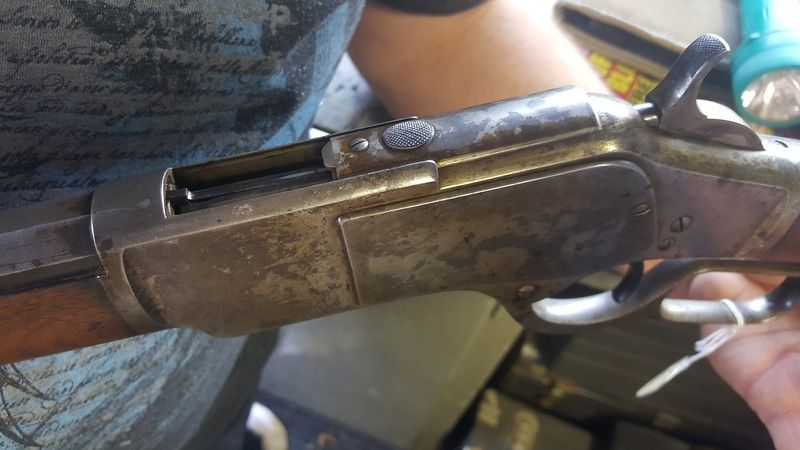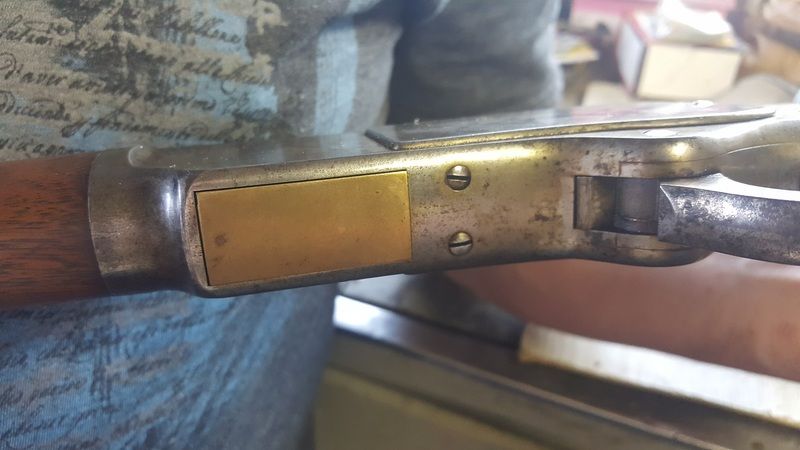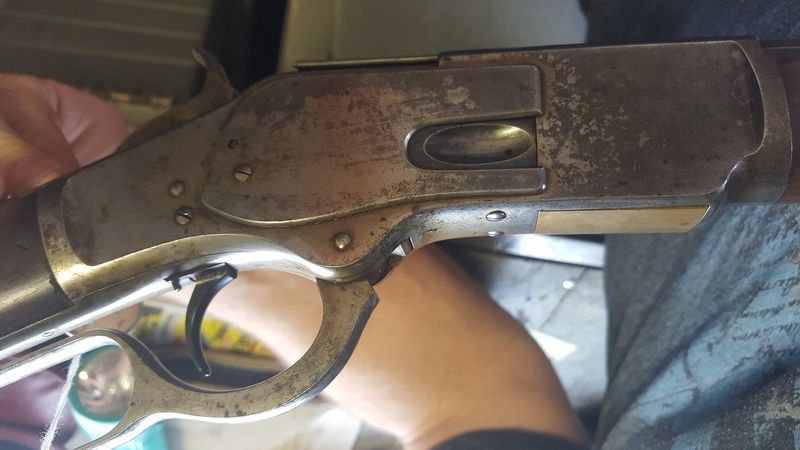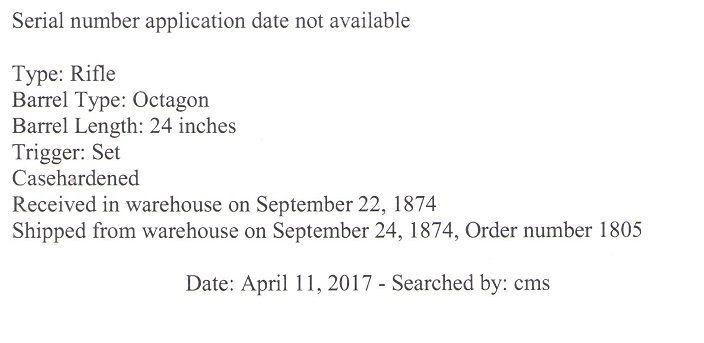November 7, 2014
 Offline
OfflineI am in the middle of packing up for a move and I have been trying to stay away from buying anything right now, which seems pretty funny that I would get an opportunity to make an offer on a collection yesterday. There were some nice examples in the group but the one that really stood out to me was this 1873 chambered in 44-40. According to Bert’s book it was made in 1874 and I sent in a request to Jessica this morning for the serial number info. The serial is just under 2000, btw. The curious part is that there is no caliber designation anywhere, not on the top of the barrel or on the cartridge lifter. Also the trigger has a very tiny screw sticking out on the right rear of it, like an adjustment screw. The trigger break is superb and I was thinking it may be a single set trigger? I could not figure out any more on that subject. The metal finish sure looks like it was a case color that has faded to silver. It is a rifle length octagon, I believe it is 24″ and has a standard crescent butt. Sorry for not getting pics of the whole rifle but the owner was not really excited about taking pics at all.
Anything you guys can tell me on this one would be greatly appreciated. I am planning to make an offer on it later this week, not sure where to start.
August 11, 2015
 Offline
OfflineThat is a first model 1873 rifle. They only offered it in 44-40 so there was no caliber designation necessary. It looks to have a set trigger and the letter should confirm that if original, which is probably the case.
The cased coloring is something for the experts. I have a couple cased color guns and your example does not look like it has gone to silver. I would think the Cody letter would also confirm cased coloring.
Would also need more detailed pictures on the barrel and stock to fully evaluate originality. I tend to buy things I like but have learned to do more evaluation so as not to get something that is not original.
May 2, 2009
 Offline
OfflineBrian Mathews said
I just got the letter info back and it is case color:Can someone describe the operation of the set trigger on this rifle? Is it like a regular SST where you push it forward to set or something different?
Thanks
You can use the trigger like a normal trigger or you can set it by pushing it forward and you will hear a slight click. The adjustment screw adjusts how hair of a trigger you want but you can adjust it to the point that it does not set at all. Be very careful about adjusting the screw since its so fine it can twist off if its froze.
Bob
WACA Life Member--- NRA Life Member---- Cody Firearms member since 1991 Researching the Winchester 1873's

Email: [email protected]
November 7, 2015
 Online
OnlineMoving is pretty hectic but it appears taking the time off to make an offer on this collection may be time well spent.
December 1, 2012
 Offline
OfflineHuck Riley said
I may be wrong but agree about the worn nickel look. Could it have been nickeled after leaving the factory? Looks like my worn nickel 66 and not like my 86 cc gone to silver.
Same here. Doesn’t look at all like any of my several “turned to silver” CC receivers (1885’s & 1886’s) but does look very much like my one nickled receiver (1876).
![]()
"This is the West, sir. When the legend becomes fact, print the legend."
May 2, 2009
 Offline
OfflineOne way to tell is to open a side plate and look inside, you will either see nice case colors or nice nickle.
Bob
WACA Life Member--- NRA Life Member---- Cody Firearms member since 1991 Researching the Winchester 1873's

Email: [email protected]
November 7, 2015
 Online
OnlineI guess that’s what fascinates me about these old Winchesters and other guns of this era; I wish I could hear the stories they could tell. IIRC (and I generally don’t!) CCH and nickel plating don’t get along very well.
June 24, 2015
 Offline
OfflineThis rifle is not nickel plated and never was. What you see is how very early Winchester case hardening wears. 1st model 1873’s and early model 1876’s will turn silver and reveal an almost “flaked” or “patchy” look with the right amount of handling wear. This does resemble nickel. Later case coloring turns a more uniform silver. I believe what we are seeing is a very thin scale that wears off revealing a metal substrate more susceptible to turn to a patina. Something in the process or formula changed after the first couple years of color case hardening. This is something I have only observed personally, it is not documented.
Austin
November 7, 2015
 Online
OnlineThat certainly makes sense, Austin. I get the impression that this rifle has been handled very little over the past several decades. I can’t imagine why anyone would nickel plate a CCH gun.
April 15, 2005
 Offline
OfflineAustin,
First, I agree that the rifle in question was never nickel plated, and that it is typical of the early Winchester case color finished receivers. I see the exact same thing on the early Model 1885 Single Shot Rifles.
It is my belief that the early case color finished receivers age & wear differently due to the alloy of the steel. The early Models (1873, 1876, & 1885) had a higher iron content and very little (if any) nickel steel. The later made guns had a higher nickel content in the steel, which resulted in a “silver” looking finish when the case colors faded or wore off.
Bert
WACA Historian & Board of Director Member #6571L

1 Guest(s)


 Log In
Log In












